St. Mary the Virgin - A Closer Look
 The
Church in the Forest otherwise known as St. Mary the Virgin Santon Downham is
set in a most tranquil spot on the edge of the forest at the end of a large
village green. There are regular services held here every Sunday at 9.30. The
first and fourth of each month being a family service, Eucharist is held on the
second and third Sunday and the fifth is a rotational service between St.
Peters, Brandon, and St.Peter and St. Patrick, Elveden. There is a thriving
Church community in this small village with many villagers helping to keep it
that way - from the daily jobs such as unlocking the church, to the weekly jobs;
flowers and cleaning, to the seasonal jobs such as cooking for and hosting the
church teas on Sundays throughout the summer months, and finally the menfolk who
willingly volunteer to mow the grass during the summer months!
The
Church in the Forest otherwise known as St. Mary the Virgin Santon Downham is
set in a most tranquil spot on the edge of the forest at the end of a large
village green. There are regular services held here every Sunday at 9.30. The
first and fourth of each month being a family service, Eucharist is held on the
second and third Sunday and the fifth is a rotational service between St.
Peters, Brandon, and St.Peter and St. Patrick, Elveden. There is a thriving
Church community in this small village with many villagers helping to keep it
that way - from the daily jobs such as unlocking the church, to the weekly jobs;
flowers and cleaning, to the seasonal jobs such as cooking for and hosting the
church teas on Sundays throughout the summer months, and finally the menfolk who
willingly volunteer to mow the grass during the summer months!
Church History
The Domesday Survey of 1086 notes the existence of a church in the village,
most probably wooden and replaced by the present one. The church has a nave,
chancel, north porch and a tower. The oldest part of the church is the western
part of the nave, which is clearly Norman and dates from the 12th century. It
has very thick walls and two doorways and windows facing each other. On the
inside, each window characteristically displays round headed splays, these were
later disguised/updated on the outside with pointed lancets. 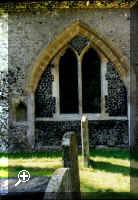 This
little church contains some fascinating anomalies: next to the North porch
outside, there is evidence of an additional or most probably an earlier Trinity
chapel; there is an arch filled with knapped flint and to the east a very well
preserved piscina. The little niche above the door in the porch is off centre,
indicating that the much thicker east wall of the porch was originally the West
side of this chapel, probably destroyed during the Reformation.
This
little church contains some fascinating anomalies: next to the North porch
outside, there is evidence of an additional or most probably an earlier Trinity
chapel; there is an arch filled with knapped flint and to the east a very well
preserved piscina. The little niche above the door in the porch is off centre,
indicating that the much thicker east wall of the porch was originally the West
side of this chapel, probably destroyed during the Reformation.
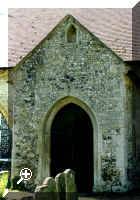 The
North porch; notice the off centre niche above the door in which a figure of the
Virgin Mary, to whom the church is dedicated, would have been housed.
The
North porch; notice the off centre niche above the door in which a figure of the
Virgin Mary, to whom the church is dedicated, would have been housed.
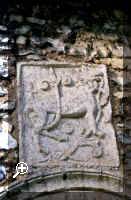 Above
the South doorway there is a carved stone panel depicting what could be a wolf (symbolising
evil) devouring the tree of life, which, indestructible sprouts from the wolf's
tail - symbolic of the Resurrection?
Above
the South doorway there is a carved stone panel depicting what could be a wolf (symbolising
evil) devouring the tree of life, which, indestructible sprouts from the wolf's
tail - symbolic of the Resurrection?
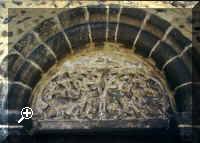 Similar
depictions can be seen below, firstly on the Norman tympanum of the Tree of Life
at Wordwell, (which can be found on the right side of the B1106 if travelling
towards Bury St Edmunds)
Similar
depictions can be seen below, firstly on the Norman tympanum of the Tree of Life
at Wordwell, (which can be found on the right side of the B1106 if travelling
towards Bury St Edmunds)
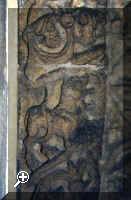 Secondly
on two Capitals in the North transept of Ely Cathedral - contemporary work and
also in the detailed carvings around the Prior's (head monk's) Door on the South
side see below.
Secondly
on two Capitals in the North transept of Ely Cathedral - contemporary work and
also in the detailed carvings around the Prior's (head monk's) Door on the South
side see below.
The Tower
The tower was built between 1460 and 1500 by a consortium of local
benefactors who had their names inscribed in stone at the base of the tower and
whose wills show them to be closely related - as one would expect in such a
small community. Here, thanks to detailed notes on the church courtesy of John
Fitch M. A. aided by Mr. Peter Rattlesden the inscriptions are brought to life:
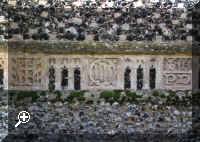 "On
the North face of the Tower are three carved panels: (left to right) the crowned
M monogram of the Virgin Mary; the HIS (Jesus) monogram in a twisted wreath with
a "fleur de lis" in each corner and in the third panel what appear to
be the letters IS and IR with, between them the emblem of priesthood (a chalice
and Host) in the top half and on the lower the letters P.D.".
"On
the North face of the Tower are three carved panels: (left to right) the crowned
M monogram of the Virgin Mary; the HIS (Jesus) monogram in a twisted wreath with
a "fleur de lis" in each corner and in the third panel what appear to
be the letters IS and IR with, between them the emblem of priesthood (a chalice
and Host) in the top half and on the lower the letters P.D.".
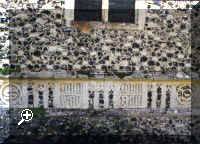 On
the west face four panels; (left to right) the interwined letters ST (Sancta
Trinitas?); John Watt; John Reeve; the Agnus Dei emblem. On the South side are
four names which, worn though they are, Mr Rattlesden plausibly deciphers as Sir
John Dowham, Margaret Reve, Jafrey Skytte and William Toller."
On
the west face four panels; (left to right) the interwined letters ST (Sancta
Trinitas?); John Watt; John Reeve; the Agnus Dei emblem. On the South side are
four names which, worn though they are, Mr Rattlesden plausibly deciphers as Sir
John Dowham, Margaret Reve, Jafrey Skytte and William Toller."
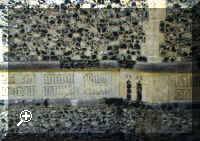 Leaving
out some unexplained initials on the North side the six individual names on the
tower all made or are mentioned in Wills between 1463 and 1504.
Leaving
out some unexplained initials on the North side the six individual names on the
tower all made or are mentioned in Wills between 1463 and 1504.
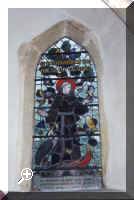 The
final unsolved problem in the history of this little church is inside. On the
South wall high up opposite the pulpit is an arch containing examples of
mediaeval scroll painting but which bears relation to nothing else in church.
This can be seen in the picture below and, if one downloads the Ipix Viewer,
insitu.
The
final unsolved problem in the history of this little church is inside. On the
South wall high up opposite the pulpit is an arch containing examples of
mediaeval scroll painting but which bears relation to nothing else in church.
This can be seen in the picture below and, if one downloads the Ipix Viewer,
insitu.
Internal Furnishings
Within are a 13th or 14th century font and an early 14th century screen,
crude and heavy in design but with a curious roughly cut double arch in one
panel of the dado, possibly a primitive confessional. The altar cross,
candlesticks and the processional cross all in wood are modern and made by a
local forester. There are some fragments of mediaeval glass in the South chancel
window but othe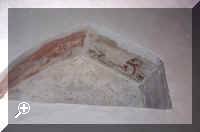 rwise
all the stained glass is Victorian, the best of which are three charming lancet
windows on the North side representing Faith Hope and Charity. On the South wall
of the chancel there is a window by Harcourt Doyle (1952) depicting St. Francis
amid Breckland flora and fauna - note the kingfisher.
rwise
all the stained glass is Victorian, the best of which are three charming lancet
windows on the North side representing Faith Hope and Charity. On the South wall
of the chancel there is a window by Harcourt Doyle (1952) depicting St. Francis
amid Breckland flora and fauna - note the kingfisher.
The memorials relate to the various landowners and their families connected
with the village, nobably the Wright's from the 17th and 18th centuries, through
the Cadogans to the last 'squire', Colonel Edward Mackenzie who died in1929.
Outside in the graveyard, near the gate is to be found the remains of a
mediaeval churchyard cross, from the time when a single cross or crucifix
commemorated all souls.
The Register of Baptisms, Marriages and Burials dates from 1579 and is
complete from that date.
Sally McIrvine, Santon Downham. December 2000
Acknowledgement: 'The Church in the Forest' by Canon John Fitch, M. A.